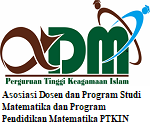On the Relation of the Total Graph of a Ring and a Product of Graphs
DOI:
https://doi.org/10.15642/mantik.2022.8.2.99-104Keywords:
Group, Total graph, Isomorphism, Cartesian productAbstract
The total graph of a ring R, denoted as T(Γ(R)), is defined to be a graph with vertex set V(T(Γ(R)))=R and two distinct vertices u,v∈V(T(Γ(R))) are adjacent if and only if u+v∈Z(R), where Z(R) is the zero divisor of R. The Cartesian product of two graphs G and H is a graph with the vertex set V(G×H)=V(G)×V(H) and two distinct vertices (u_1,v_1 ) and (u_2,v_2 ) are adjacent if and only if: 1) u_1=u_2 and v_1 v_2∈H; or 2) v_1=v_2 and u_1 u_2∈E(G). An isomorphism of graphs G dan H is a bijection ϕ:V(G)→V(H) such that u,v∈V(G) are adjacent if and only if f(u),f(v)∈V(H) are adjacent. This paper proved that T(Γ(Z_2p )) and P_2×K_p are isomorphic for every odd prime p.
Downloads
References
G. Aalipour and S. Akbari, “Application of some combinatorial arrays in coloring of total graph of a commutative ring,” May 2013.
J. D. LaGrange, “Weakly central-vertex complete graphs with applications to commutative rings,” J. Pure Appl. Algebr., vol. 214, no. 7, pp. 1121–1130, Jul. 2010.
A. Abdollahi, “Commuting graphs of full matrix rings over finite fields,” Linear Algebra Appl., 2008.
R. P. Grimaldi, “Graphs from rings,” Congr. Numer, vol. 71, pp. 95–104, 1990.
J. S. Golan, “The theory of semirings with applications in mathematics and theoretical computer science.,” p. 318, 1992.
D. F. Anderson, T. Asir, A. Badawi, and T. Tamizh Chelvam, Graphs from Rings. 2021.
A. Kelarev, J. Ryan, and J. Yearwood, “Cayley graphs as classifiers for data mining: The influence of asymmetries,” Discrete Math., vol. 309, no. 17, pp. 5360–5369, Sep. 2009.
S. Y. Hsieh, C. W. Huang, and H. H. Chou, “A DNA-based graph encoding scheme with its applications to graph isomorphism problems,” Appl. Math. Comput., vol. 203, no. 2, pp. 502–512, Sep. 2008.
M. Grohe and P. Schweitzer, “The graph isomorphism problem,” Commun. ACM, vol. 63, no. 11, pp. 128–134, 2020.
V. Bonnici, R. Giugno, A. Pulvirenti, D. Shasha, and A. Ferro, “A subgraph isomorphism algorithm and its application to biochemical data,” BMC Bioinformatics, vol. 14, no. SUPPL7, pp. 1–13, Apr. 2013.
C. S. Calude, M. J. Dinneen, and R. Hua, “QUBO formulations for the graph isomorphism problem and related problems,” Theor. Comput. Sci., vol. 701, pp. 54–69, Nov. 2017.
X. Y. Jiang and H. Bunke, “Including geometry in graph representations: A quadratic-time graph isomorphism algorithm and its applications,” Lect. Notes Comput. Sci. (including Subser. Lect. Notes Artif. Intell. Lect. Notes Bioinformatics), vol. 1121, pp. 110–119, 1996.
R. Diestel, “Graph Theory (5th Edition),” Springer, 2017.
J. Gallian, Contemporary Abstract Algebra. 2021.
D. F. Anderson and A. Badawi, “The total graph of a commutative ring,” J. Algebr., vol. 320, no. 7, pp. 2706–2719, Oct. 2008.
Downloads
Published
How to Cite
Issue
Section
License
Copyright (c) 2022 Mohammad Nafie Jauhari

This work is licensed under a Creative Commons Attribution-NonCommercial-ShareAlike 4.0 International License.
- Authors retain copyright and grant the journal right of first publication with the work simultaneously licensed under a Creative Commons License that allows others to share the work with an acknowledgment of the work's authorship and initial publication in this journal.
- Authors are able to enter into separate, additional contractual arrangements for the non-exclusive distribution of the journal's published version of the work (e.g., post it to an institutional repository or publish it in a book), with an acknowledgment of its initial publication in this journal.
- Authors are permitted and encouraged to post their work online (e.g., in institutional repositories or on their website) prior to and during the submission process, as it can lead to productive exchanges, as well as earlier and greater citation of published work







.png)




